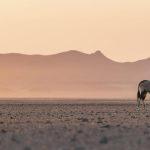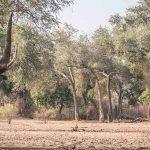Damaraland is an environment of extremes. With little vegetation and water, it’s quite unbelievable that anything survives here. But through huge conservation efforts including the daily monitoring and anti-poaching patrols, the desert black rhino is thriving in this region.
Sam visited the area earlier in the year and after successfully locating and enjoying some magnificent black rhino sightings on foot, a Q&A session was held with the Save the Rhino Trust tracker.
How long has Save The Rhino Trust been going?
Since 1989 we have been working to protect rhinos as well as the other wildlife in the area.
What is the state of poaching now in Namibia?
In Damaraland, the poaching rates have fallen a lot due to our ongoing efforts.
But incursions by poachers still occur and the number varies, going up and down. Our biggest threat is full moon, when the night is brightest and poachers can see without the need of a torch/flashlight.
Where does the most poaching happen?
The main hub of poaching is in our National Parks and game reserves, even though they are fully protected, corruption can happen and the areas are vast. Poverty is playing a big role in poaching, with the amount of money offered, poaching can be an enticing way for some of the local people to make a quick buck.
What is the penalty for poaching?
In Botswana they give a life sentence. In South Africa it’s 25 to 30 years in prison. It’s always the local poachers who get convicted, not the middle-men or king-pins of the syndicates.
The locals may be approached with around $500 US dollars and in return they give the locations of the rhino. $500 is a huge amount of money for people living in poverty. They can help support their families.
Are you seeing a decrease in poaching due to the dehorning project?
Yes, dehorning is solely for the rhinos protection. Although it’s sad for them not to look as a rhino should with their horns, dehorning them reduces rhinos value to poachers. The long-term effect on rhino behaviour is still being monitored though.
How much do rhino horns sell for?
Rhino horn is more valuable on the black market than gold. Per kilogram, a rhino’s horn – which is made of keratin, the same makeup of your fingernails – is worth an average USD $15,000.
Overall, what is Save the Rhino Trust doing?
Save the Rhino Trust has established an extensive database documenting, through photographic and life-history records, the area’s black rhinos. Given the continued threats posed in Namibia by organised criminal gangs, it is essential that Save the Rhino Trust maintains its intensive patrolling, which, based on poaching data, is a contributing factor to deter potential poachers. In the process, other species on the landscape such as desert lions, elephants, and giraffes also benefit from the increased surveillance and monitoring activities.
If you’d like to get involved with tracking black rhino in Damaraland, please schedule a call with Sam to find out how you can do so.








